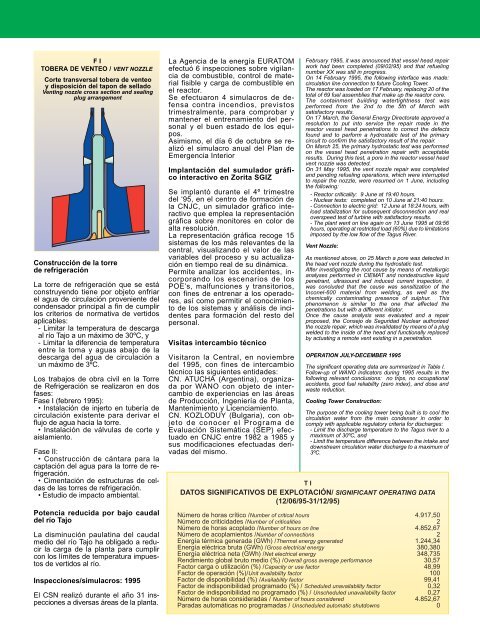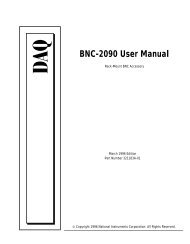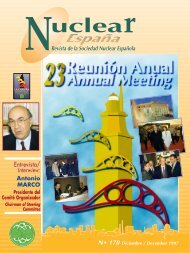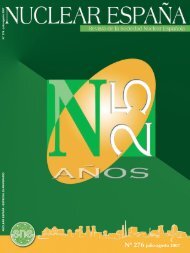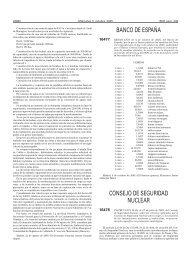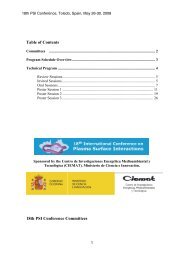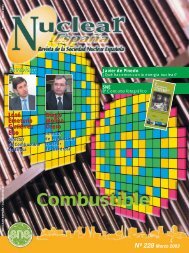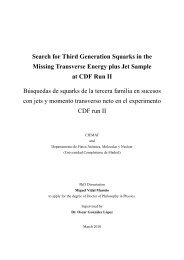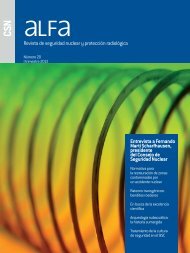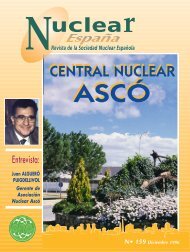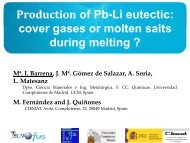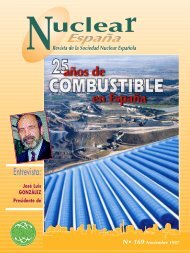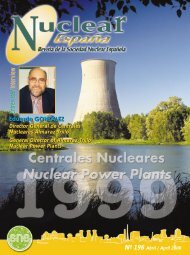The major activities were:• 1 reactor cooling pump revision.• 1 low-pressure turbine revision.• Fuel balancing pin inspection.• Essential service cooling system modification.• 24 V d.c. system modification.• Residual heat removal chain modification.Other relevant activities:Activities continued in the Information Center, whichreceived more than 13,000 visitors. More than 31,000man-hours were devoted to training. Other multiannualprogramas were continued, such asreplacement of the Association’s Information Systemsand PSA development, phase 1 of which is scheduledfor completion in the summer of 1996.A new three-year collective agreement was alsosigned, and new spent fuel racks were engineered andmanufactured and will be installed throughout this year.LONG-TERM ACTIVITIES: DEVELOPMENT ANDPERSPECTIVESThe most important aspect in this area is the OperatingExperience and Systems Analysis Program (AEOS). Thisis an exercise in self-evaluation that is being carried out tocheck that safety systems comply with all design-imposedconditions and that assembly has been consistent in all ofthem. It is being conducted by a work team led by TrilloNPP and in which personnel from engineering firms of theplant’s owner companies, the main engineer and the mainsupplier are participating. The program has beenfavorably assessed by the CSN.As a result of this program, mostly documentaldiscrepancies have been detected, and the mostimportant physical discrepancies have resulted in themodifications discussed below:• Modification of the 24 V direct current system:This was intended to increase battery capacity anddecrease possible load losses in the system as much aspossible. For this purpose, 104 new battery assemblies,new interconnection conduits to the d.c. distribution barsand more than 32,000 meters of cable up to endconsumers were installed.• Modification of the residual heat removal chain:As a result of a cross analysis between the electricalsupport system (4 redundancies) and the mechanicalsystems (4 redundancies in ultimate sump, 3 incomponent cooling and 4 in safety injection), the powersupplies of several nuclear component cooling systemvalves and pumps have been replaced, with a majorimpact on the reactor protection system logic.Preparation of the Strategic Plan:This Plan has a 5-year time frame and combines theneeds that must be covered in the plant (with allocation ofthe appropriate resources) with the increasinglycompetitive environment in which the electricitygeneration business operates. The intent is to providelong-term guidance for the Association’s activity.EXPERIENCEAND PERSPECTIVES - 1995“JOSÉ CABRERA” <strong>POWER</strong> PLANTZORITAAquilino RODRÍGUEZINTRODUCTIONOf the 428 plants in operation around the world on31/12/95, we were among the 24 oldest, havingcompleted 28 years of operation against aPlant design life of 40 years.The total accumulated energy production of25,000.49 GWh is the equivalent of 17.8Full Power Years (FPY).OPERATION JANUARY-JUNE 1995Refueling:The year 1995 began with the Plant shutdown due to repair operations on reactorvessel head penetrations.In the last annual meeting of the SNE inredundancias en último sumidero, 3en refrigeración de componentes y 4en inyección de seguridad) se hancambiado la alimentación de variasválvulas y bombas del sistema de refrigeraciónde componentes nucleares,con un pacto importante en la lógicadel sistema de protección delreactor.Confección del Plan EstratégicoEs un Plan que, en un horizonte de 5años, combina las necesidades que esnecesario cubrir en la central (conasignación de los correspondientes recursos)con el entorno cada vez máscompetitivo en el que se desenvuelveel negocio eléctrico de producción. Sepretende que oriente la actividad de laAsociación en el largo plazo.EXPERIENCIAY PERSPECTIVAS EN 1995CENTRAL “JOSÉCABRERA” ZORITAAquilino RODRÍGUEZINTRODUCCIÓNDe las 428 centrales en explotación enel mundo al 31-12-95 nos encontramosentre las 24 más antiguas, cumpliendo28 años en explotación frentea una vida de diseño de la Planta de40 años.La energía producida total acumuladade 25.000,49 Gwh representa un equivalentede 17,8 Años de PlenaPotencia (FPY).EXPLOTACIÓN ENERO-JUNIO: 1995RecargaEl año 1995 se inicia con la Centralparada debido a las operaciones dereparación de las penetraciones de latapa de la vasija del reactor.En la pasada reunión anual de la SNEde Febrero de 1995, se manifestó quehabían finalizado los trabajos de reparaciónde la tapa de la vasija(09.02.95) y continuaba la recarga númeroXX.El 14 febrero de 1995 se efectuó la interfase:conexión línea circulación a lafutura Torre de Refrigeración.El 17 de febrero se carga elreactor, sustituyéndose 20elementos del total de 69elementos que constituyenel núcleo del reactor.Entre los días 2 al 5 de marzose realizó la prueba dehermeticidad del recinto decontención con resultadossatisfactorios.El día 17 de marzo, laDirección General de la Energía aprobómediante resolución la puesta enservicio de la reparación efectuada,para corregir los defectos encontrados,en las penetraciones de la Tapade la Vasija del reactor y la realizaciónde una prueba hidrostática del circuitoprimario para confirmar el resultadosatisfactorio de la reparación.El 25 de marzo se realizó la prueba hidrostáticadel primario con resultadosaceptables de la reparación de laspenetraciones de la Tapa de la Vasija.Durante la misma se observó un poroen la tobera de venteo de la tapa de lavasija del reactor.El 31 de mayo del 1995 finalizó la reparaciónde la tobera de venteo, reanudándoseel 1 de junio las operacionespendientes de recarga, queestaban interrumpidas por la reparaciónde la tobera, destacándose:- Criticidad del reactor: día 9 de junioa las 19:40 horas.- Pruebas nucleares: finalizan el 10de junio a las 21:40 horas.- Acoplamiento a la red eléctrica: día12 de junio a las 18:24 horas, estabilizandocarga para posterior desacopley prueba de sobrevelocidad realde la turbina con resultados satisfactorios.- El día 13 de Junio de 1995, a las09:56 horas se acopla de nuevo a lared eléctrica, operándose en cargarestringida (60%) por la limitación impuestapor el bajo caudal del río Tajo.Tobera de venteoComo se mencionó anteriormente eldía 25 de marzo se observó un poroen la tobera de venteo de la tapa, durantela prueba hidrostática.Investigada la causa raíz, medianteanálisis metalúrgicos realizados en elCIEMAT y ensayos no destructivos delíquidos penetrantes, ultrasonidos ycorrientes inducidas, se concluye quela causa era la sensibilización del materialInconel-600 por la soldadura, asícomo la presencia contaminante químico:azufre. Fenómeno similar al queafectó a las penetraciones pero con diferenteiniciador.El Consejo de Seguridad Nuclear, unavez evaluado el análisis de causa y lapropuesta de reparación, autorizó lareparación de la tobera, anulándolamediante un tapón soldado al interiorde la tapa y sustituyendo su funciónmediante la actuación de venteo remotoexistente en una penetración.EXPLOTACIÓNJULIO-DICIEMBRE 1995Los datos significativos de explotaciónse resumen en la tabla I.El seguimiento de los indicadores WA-NO durante el año 1995 llevan a la siguienteconclusión relevante: ningúndisparo, ningún accidente laboral, buenafiabilidad del combustible (índicecero) y reducción de dosis y residuos.
F ITOBERA DE VENTEO / VENT NOZZLECorte transversal tobera de venteoy disposición del tapon de selladoVenting nozzle cross section and sealingplug arrangementConstrucción de la torrede refrigeraciónLa torre de refrigeración que se estáconstruyendo tiene por objeto enfriarel agua de circulación proveniente delcondensador principal a fin de cumplirlos criterios de normativa de vertidosaplicables:- Limitar la temperatura de descargaal río Tajo a un máximo de 30ºC, y- Limitar la diferencia de temperaturaentre la toma y aguas abajo de ladescarga del agua de circulación aun máximo de 3ºC.Los trabajos de obra civil en la Torrede Refrigeración se realizaron en dosfases:Fase I (febrero 1995):• Instalación de injerto en tubería decirculación existente para derivar elflujo de agua hacia la torre.• Instalación de válvulas de corte yaislamiento.Fase II:• Construcción de cántara para lacaptación del agua para la torre de refrigeración.• Cimentación de estructuras de celdasde las torres de refrigeración.• Estudio de impacto ambiental.Potencia reducida por bajo caudaldel río TajoLa disminución paulatina del caudalmedio del río Tajo ha obligado a reducirla carga de la planta para cumplircon los límites de temperatura impuestosde vertidos al río.Inspecciones/simulacros: 1995El CSN realizó durante el año 31 inspeccionesa diversas áreas de la planta.La Agencia de la energía EURATOMefectuó 6 inspecciones sobre vigilanciade combustible, control de materialfisible y carga de combustible enel reactor.Se efectuaron 4 simulacros de defensacontra incendios, previstostrimestralmente, para comprobar ymantener el entrenamiento del personaly el buen estado de los equipos.Asimismo, el día 6 de octubre se realizóel simulacro anual del Plan deEmergencia InteriorImplantación del sumulador gráficointeractivo en Zorita SGIZSe implantó durante el 4º trimestredel ‘95, en el centro de formación dela CNJC, un simulador gráfico interactivoque emplea la representacióngráfica sobre monitores en color dealta resolución.La representación gráfica recoge 15sistemas de los más relevantes de lacentral, visualizando el valor de lasvariables del proceso y su actualizaciónen tiempo real de su dinámica.Permite analizar los accidentes, incorporandolos escenarios de losPOE’s, malfunciones y transitorios,con fines de entrenar a los operadores,así como permitir el conocimientode los sistemas y análisis de incidentespara formación del resto delpersonal.Visitas intercambio técnicoVisitaron la Central, en noviembredel 1995, con fines de intercambiotécnico las siguientes entidades:CN. ATUCHA (Argentina), organizadapor WANO con objeto de intercambiode experiencias en las áreasde Producción, Ingeniería de Planta,Mantenimiento y Licenciamiento.CN. KOZLODUY (Bulgaria), con objetode conocer el Programa deEvaluación Sistemática (SEP) efectuadoen CNJC entre 1982 a 1985 ysus modificaciones efectuadas derivadasdel mismo.February 1995, it was announced that vessel head repairwork had been completed (09/02/95) and that refuelingnumber XX was still in progress.On 14 February 1995, the following interface was made:circulation line connection to future Cooling Tower.The reactor was loaded on 17 February, replacing 20 of thetotal of 69 fuel assemblies that make up the reactor core.The containment building watertightness test wasperformed from the 2nd to the 5th of March withsatisfactory results.On 17 March, the General Energy Directorate approved aresolution to put into service the repair made in thereactor vessel head penetrations to correct the defectsfound and to perform a hydrostatic test of the primarycircuit to confirm the satisfactory result of the repair.On March 25, the primary hydrostatic test was performedon the vessel head penetration repair with acceptableresults. During this test, a pore in the reactor vessel headvent nozzle was detected.On 31 May 1995, the vent nozzle repair was completedand pending refueling operations, which were interruptedto repair the nozzle, were resumed on 1 June, includingthe following:- Reactor criticality: 9 June at 19:40 hours.- Nuclear tests: completed on 10 June at 21:40 hours.- Connection to electric grid: 12 June at 18:24 hours, withload stabilization for subsequent disconnection and realoverspeed test of turbine with satisfactory results.- The plant went on line again on 13 June 1995 at 09:56hours, operating at restricted load (60%) due to limitationsimposed by the low flow of the Tagus River.Vent Nozzle:As mentioned above, on 25 March a pore was detected inthe head vent nozzle during the hydrostatic test.After investigating the root cause by means of metallurgicanalyses performed in CIEMAT and nondestructive liquidpenetrant, ultrasound and induced current inspection, itwas concluded that the cause was sensitization of theInconel-600 material from welding, as well as thechemically contaminating presence of sulphur. Thisphenomenon is similar to the one that affected thepenetrations but with a different initiator.Once the cause analysis was evaluated and a repairproposed, the Consejo de Seguridad Nuclear authorizedthe nozzle repair, which was invalidated by means of a plugwelded to the inside of the head and functionally replacedby actuating a remote vent existing in a penetration.OPERATION JULY-DECEMBER 1995The significant operating data are summarized in Table I.Follow-up of WANO indicators during 1995 results in thefollowing relevant conclusions: no trips, no occupationalaccidents, good fuel reliability (zero index), and dose andwaste reduction.Cooling Tower Construction:The purpose of the cooling tower being built is to cool thecirculation water from the main condenser in order tocomply with applicable regulatory criteria for discharges:- Limit the discharge temperature to the Tagus river to amaximum of 30ºC, and- Limit the temperature difference between the intake anddownstream circulation water discharge to a maximum of3ºC.T IDATOS SIGNIFICATIVOS DE EXPLOTACIÓN/ SIGNIFICANT OPERATING DATA(12/06/95-31/12/95)Número de horas crítico /Number of critical hours 4.917,50Número de criticidades /Number of criticalities 2Número de horas acoplado /Number of hours on line 4.852,67Número de acoplamientos /Number of connections 2Energía térmica generada (GWh) /Thermal energy generated 1.244,34Energía eléctrica bruta (GWh) /Gross electrical energy 380,380Energía eléctrica neta (GWh) /Net electrical energy 348,735Rendimiento global bruto medio (%) /Overall gross average performance 30,57Factor carga o utilización (%) /Capacity or use factor 48,99Factor de operación (%)/Unit availability factor 100Factor de disponibilidad (%) /Availability factor 99,41Factor de indisponibilidad programado (%) / Scheduled unavailability factor 0,32Factor de indisponibilidad no programado (%) / Unscheduled unavailability factor 0,27Número de horas consideradas / Number of hours considered 4.852,67Paradas automáticas no programadas / Unscheduled automatic shutdowns 0


